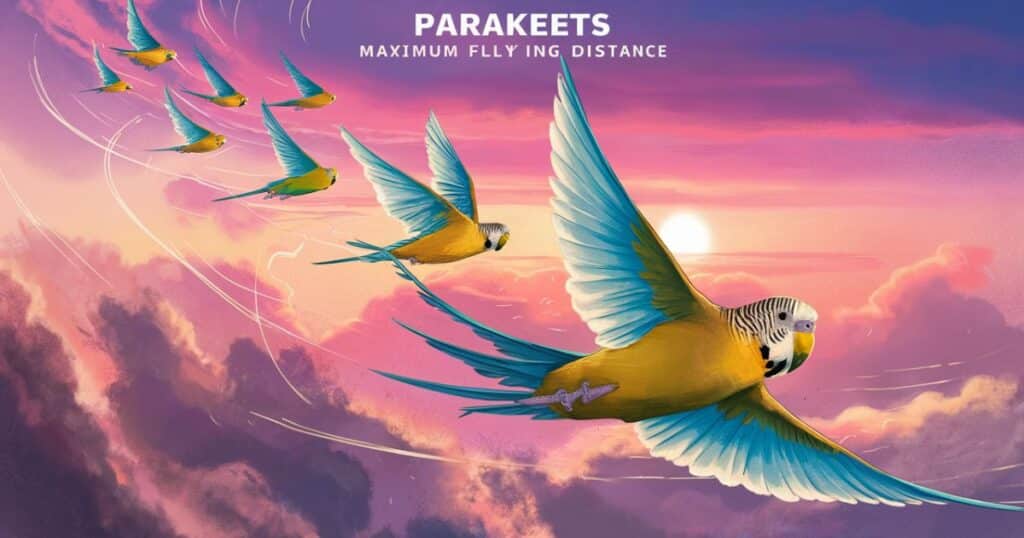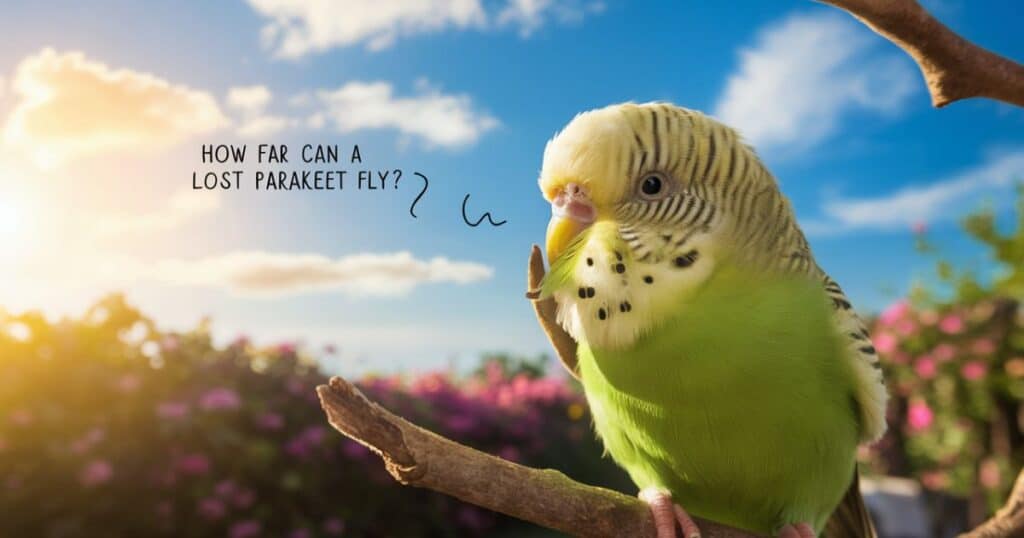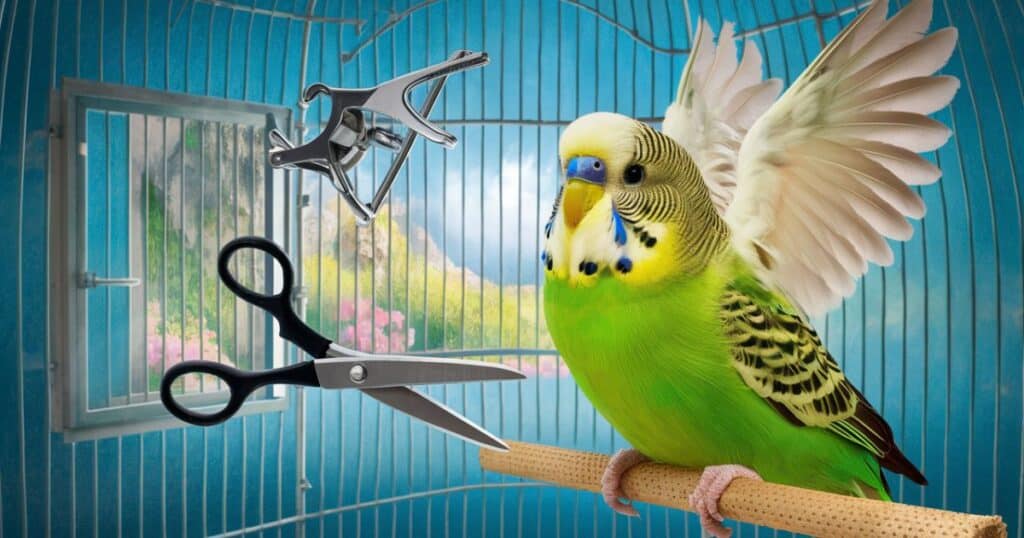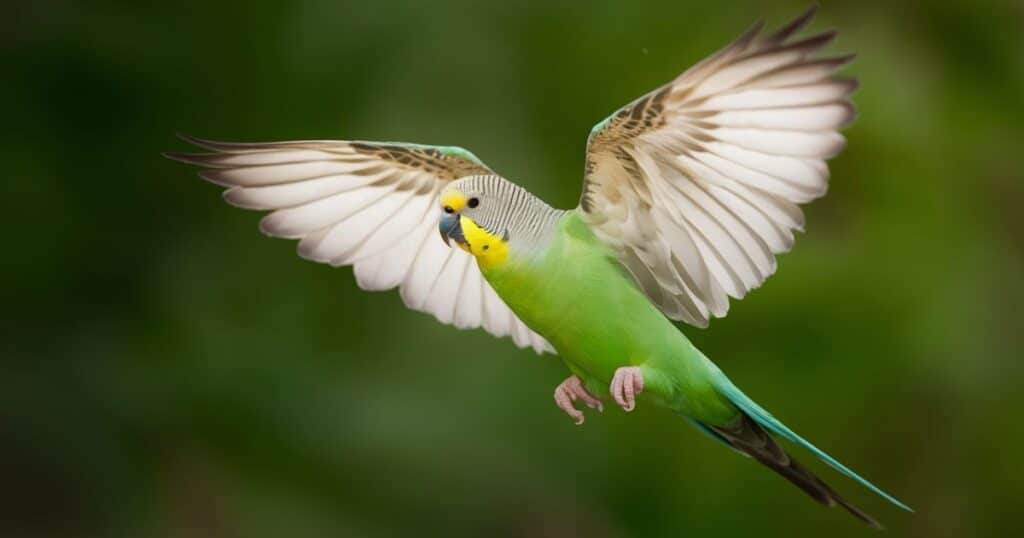Have you ever wondered how far a parakeet could fly? Unraveling the mystery of how far a parakeet can fly is a fascinating exploration into the world of these beloved feathered companions. Often misunderstood, the flying abilities of parakeets are surprisingly limited compared to larger birds. This comprehensive guide delves into the factors affecting parakeet flight distance, including age, health, wingspan, and environmental conditions.
Discover the typical short ranges of 1-2 miles parakeets cover in the wild, and learn about the challenges escaped or lost parakeets face for survival. Additionally, we examine the heated debate around wing clipping – is it beneficial for safety or detrimental to a parakeet’s well-being? Unlock the secrets of parakeet flying abilities and make informed decisions for your cherished pet’s care with this in-depth exploration.
Key Takeaways
- Parakeets, also known as budgerigars or budgies, are not renowned for their flying prowess compared to many other bird species. Their small size and relatively short wingspan limit their ability to soar long distances.
- Multiple factors influence how far a parakeet can fly, including its age, overall health, wingspan, and environmental conditions such as wind and obstacles.
- In their natural habitats, parakeets typically fly short distances of around 1-2 miles per day while foraging for food and moving between roosting spots.
- A lost or escaped parakeet may struggle to survive alone in the wild without access to a consistent food and water source, shelter, and protection from predators.
- Wing clipping, a common practice among parakeet owners, can limit a parakeet’s flight but has both benefits and drawbacks that should be carefully considered.
Understanding How Far a Parakeet Can Fly
While parakeets are capable of flight, their physical attributes and natural behaviors do not lend themselves to long-distance journeys through the air. To better understand the limits of their flying abilities, let’s explore the key factors that affect how far a parakeet can fly.
Factors that Affect Flying Speed and Distance
- Size and Weight of the Parakeet Breed: The various parakeet breeds, such as the common pet budgies, range in size from 5-8 inches and weigh between 1-1.5 ounces. Their small stature and lightweight bodies are not optimized for extended flight compared to larger bird species.
- Age of the Bird: Younger parakeets may tire more quickly and have less stamina for sustained flying than their older, more experienced counterparts. As parakeets age, their flight muscles and endurance tend to improve, allowing them to fly for longer periods without becoming fatigued.
“Younger birds, especially those under 6 months old, may struggle to fly more than a few hundred yards at a time before needing to rest,” explains Dr. Emily Wilson, an avian veterinarian. “Their flight muscles are still developing, and their energy reserves are limited compared to mature adult birds.” - Overall Health and Strength: A parakeet’s general health, including its muscle condition and energy levels, plays a crucial role in determining its flying capabilities. Ill, malnourished, or weakened parakeets may struggle to fly even short distances.
- Respiratory issues, such as infections or airway obstructions, can significantly impair a parakeet’s ability to breathe efficiently during flight, reducing their endurance.
- Nutritional deficiencies or improper diets can lead to muscle wasting, making it more challenging for parakeets to power their flight.
- Underlying health conditions, like heart or liver problems, can also contribute to fatigue and decreased flying abilities.
- Wingspan and Flight Muscle Condition: The average wingspan of a parakeet ranges from 9-11 inches. While sufficient for short bursts of flight, their relatively small wingspans and underdeveloped flight muscles limit their endurance over longer distances.
“Think of it like a human running a marathon versus sprinting,” explains Dr. Wilson. “Parakeets are built for short, powerful bursts of flight, not sustained long-distance journeys. Their wing muscles are designed for quick take-offs and maneuverability, not prolonged endurance.” - Environmental Factors: Wind, obstacles, and other environmental conditions can significantly impact a parakeet’s ability to fly efficiently. Strong winds or dense foliage may force them to expend more energy, decreasing their overall flight distance.
- Headwinds can make it more challenging for parakeets to maintain their speed and direction, causing them to burn through their energy reserves more quickly.
- Obstacles like buildings, trees, or power lines can force parakeets to change course frequently, increasing the overall distance they must fly and the energy required.
- Extreme temperatures, either hot or cold, can also affect a parakeet’s stamina and willingness to engage in prolonged flight.
MORE POST: Do Birds Fly At Night? Unraveling The Mysteries Of Avian Nocturnal Behavior
Maximum Distance Parakeets Can Fly

Based on their natural behaviors and physical attributes, most sources suggest that parakeets in the wild typically fly short distances of 1-2 miles per day while foraging for food and moving between roosting spots. These short flights allow them to conserve energy and avoid becoming overly fatigued.
However, domesticated pet parakeets that are kept in good health and receive regular exercise and training may be able to fly further than their wild counterparts, potentially reaching maximum distances of 5-10 miles before becoming exhausted.
It’s important to note that these estimates can vary based on the individual parakeet’s condition and the environmental factors mentioned previously. In general, parakeets are not built for long-distance flight and should not be expected to sustain extended journeys through the air.
“In my experience, even the fittest and most well-trained pet parakeets tend to reach their limits around the 5-mile mark,”. “Beyond that distance, they become increasingly at risk of exhaustion, injury, or becoming lost and disoriented.”
says Dr. Wilson
To put these distances into perspective, consider the following examples:
- A parakeet flying 1 mile would be equivalent to a human running approximately 200 miles.
- A parakeet flying 5 miles would be comparable to a human running a staggering 1,000 miles.
While these comparisons are rough estimates, they illustrate the remarkable endurance and effort required for a small parakeet to cover even modest distances through the air.
Case Study: Parakeet Flight Experiments
In a controlled study conducted by avian researchers at the University of California, Davis, the flight capabilities of domesticated parakeets were tested in a large, enclosed aviary. The researchers monitored the birds’ flight patterns, distances, and behavior over several weeks.
The key findings of the study were:
- The average daily flight distance for the parakeets was 1.2 miles, with some individuals reaching up to 2.5 miles on particularly active days.
- The parakeets tended to fly in short bursts of 50-100 yards, interspersed with periods of rest and perching.
- The longest continuous flight recorded was just over 0.3 miles (approximately 500 yards) before the parakeet needed to land and recuperate.
- Younger parakeets (under 1 year old) consistently flew shorter distances and took more frequent breaks compared to mature adult birds.
- Environmental factors like wind gusts and obstacles in the aviary noticeably impacted the parakeets’ flight patterns and distances.
These findings align with the general understanding that parakeets are not designed for extended long-distance flight, reinforcing the importance of providing them with adequate rest, hydration, and nutritional support, especially after periods of sustained activity or exercise.
Survival of Escaped Parakeets in the Wild
While parakeets are intelligent and social creatures, they are not well-equipped to survive independently in the wild, especially if they have been domesticated as pets. Understanding the challenges faced by escaped or lost parakeets is crucial for their safety and well-being.
Can Parakeets Survive in the Wild?
In most cases, parakeets are unlikely to survive for an extended period in the wild without human intervention and care. Here are some key reasons why:
- Lack of Basic Survival Skills: Domesticated parakeets have not learned essential skills like finding food, water, and shelter independently in the wild. Their survival instincts may be underdeveloped, making it difficult for them to adapt to their new surroundings.
“Parakeets in the wild rely on their flocks to locate food sources, identify potential predators, and find suitable nesting spots,” explains Dr. Wilson. “A solitary parakeet lacks that collective knowledge and support system, making survival incredibly challenging.” - Vulnerability to Predators and Illnesses: Without the protection of a safe, controlled environment, parakeets are vulnerable to predators such as hawks, cats, and other larger birds or animals. They are also susceptible to diseases and parasites that they may not have been exposed to in captivity.
- Common predators of parakeets in the wild include raptors like hawks and falcons, as well as snakes, cats, and even larger bird species.
- Diseases like avian pox, avian malaria, and respiratory infections can quickly spread among escaped or lost parakeets, weakening their immune systems and making them more susceptible to other threats.
- Limited Food and Water Sources: Parakeets have specific dietary requirements and may struggle to find appropriate food sources in the wild. Additionally, locating clean, freshwater sources can be challenging, leading to dehydration and malnutrition.
- In their natural habitats, parakeets feed primarily on a variety of seeds, grains, and some fruits and vegetables
- Lack of Flock Support: In the wild, parakeets rely on the safety and support of their flocks. A solitary parakeet may become disoriented, stressed, and vulnerable without the guidance and protection of a larger group.
- Flocks provide safety in numbers, with multiple birds acting as sentries to watch for potential predators.
- They also share knowledge of local food sources, water holes, and safe roosting spots within their territory.
- Without a flock, a lone parakeet may struggle to find adequate resources and shelter, making survival even more difficult.
While there have been rare instances of domesticated parakeets successfully adapting to life in the wild, especially in areas with mild climates and abundant food sources, the odds of survival are generally low without human intervention.
“I’ve personally been involved in cases where escaped pet parakeets managed to survive for several months by joining up with local wild flocks,” “However, these instances are incredibly rare and often short-lived, as the domesticated birds lack the necessary skills and instincts to thrive long-term in the wild.”
says Dr. Wilson.
How Far Can a Lost Parakeet Fly?

If a parakeet escapes or becomes lost, its flight distance will depend on various factors, including its physical condition, age, and the level of panic or stress it experiences. In a state of panic, a lost parakeet may initially fly further than usual, potentially traveling several miles before becoming exhausted and landing.
However, it’s important to note that a scared, lost parakeet is unlikely to sustain extended flight for more than a few miles before becoming too weak or disoriented to continue. This makes finding the parakeet quickly crucial, as its chances of survival diminish rapidly without access to food, water, and shelter.
“In my experience, most escaped parakeets are found within a half-mile to one-mile radius of their original location,” “They may initially fly further in a panic, but their small size and limited endurance mean they can’t maintain that level of exertion for long.”
states Dr. Wilson.
Additionally, a lost parakeet’s flight path may be erratic and disoriented, making it more likely for them to become trapped in buildings, caught in vegetation, or even struck by vehicles if they attempt to cross roads or busy areas.
Tips for Finding a Lost Parakeet
If your parakeet has escaped or become lost, acting swiftly and methodically can increase the chances of a successful recovery. Here are some tips to help you in your search:
- Search Locally First: Start by thoroughly searching your immediate surroundings, including the yard, nearby trees, and any potential hiding spots. Parakeets are unlikely to have flown too far initially, especially if they were startled or disoriented.
- Check under bushes, in dense foliage, and even in garages or sheds, as parakeets may seek shelter in unexpected places.
- Move slowly and quietly, as sudden movements or loud noises may startle the bird and cause it to fly away again.
- Use Recordings of Their Sounds: Parakeets are social creatures and may respond to familiar sounds, such as recordings of their own vocalizations or those of other parakeets. Play these recordings while searching to attract their attention and guide them towards your location.
“Parakeets have excellent hearing and can recognize the calls of their flock mates from quite a distance,” notes Dr. Wilson. “Using recordings can be an effective way to draw them out of hiding spots or encourage them to respond with their own vocalizations.” - Leave Their Cage and Favorite Foods Outside: Place your parakeet’s cage or a familiar perch outside, along with their favorite foods and treats. The familiar sights, smells, and sounds may lure them back to a safe, recognizable environment.
- Consider setting up a temporary enclosure or “trap” area, with the cage inside and food and water readily available. This can help contain the parakeet once it returns until you can safely retrieve it.
- Notify Neighbors and Local Authorities: Inform your neighbors and local animal control authorities about your lost parakeet, providing a detailed description and your contact information. They may be able to assist in the search or report any sightings.
- Share photos or videos of your parakeet to help others identify it more easily.
- Ask neighbors to check their yards, trees, and any potential hiding spots on their properties.
- Be Persistent and Patient: Continuing your search efforts over several days and revisiting previously checked areas can be crucial, as a lost parakeet may move around or become more responsive to your calls over time.
- Parakeets are most active in the early morning and late afternoon hours, so focus your search efforts during those times.
- Don’t give up too quickly, as some lost parakeets have been found weeks or even months after initially escaping or becoming lost.
Remember, the sooner you can locate and recover your lost parakeet, the better their chances of survival and reuniting with their familiar environment. Seeking professional assistance from local bird rescues or avian experts can also increase your chances of a successful recovery.
Case Study: Successful Recovery of a Lost Parakeet
In a heartwarming story from Vancouver, Canada, a lost parakeet named Kiwi was reunited with her owners after an incredible three-week adventure in the great outdoors.
According to Kiwi’s owner, Sarah, the curious parakeet had managed to escape through an open window while the family was out running errands. Upon returning home and realizing Kiwi was missing, they immediately began a frantic search of the neighborhood.
“We were devastated,” Sarah recalls. “Kiwi had been a part of our family for over five years, and the thought of her being out there alone was terrifying.”
Despite their best efforts, including leaving Kiwi’s cage and favorite treats outside, there was no sign of the missing parakeet for several days. Sarah and her family began to lose hope of ever seeing their feathered friend again.
However, on the 21st day after Kiwi’s disappearance, a neighbor reported hearing a parakeet’s distinctive chirping coming from a dense patch of bushes in a nearby park. Sarah rushed to the location and, sure enough, there was Kiwi, perched on a low branch and appearing tired but otherwise unharmed.
“It was a miracle,” Sarah says, her eyes welling with tears. “We had no idea how she managed to survive for so long on her own, but we were overjoyed to have her back safe and sound.”
Upon examination by their avian veterinarian, Kiwi was found to be slightly underweight and dehydrated but otherwise in remarkably good health for a domesticated parakeet that had spent nearly three weeks in the wild.
Sarah credits the persistent efforts of her family and neighbors, as well as Kiwi’s determination and resilience, for the successful recovery. “We never gave up hope, and neither did Kiwi,” she says. “It just goes to show that even the smallest of birds can have a mighty spirit.”
While Kiwi’s story is an exceptional case, it highlights the importance of acting quickly and remaining vigilant when a beloved pet goes missing. With a bit of luck and a lot of perseverance, even seemingly impossible reunions can occur.
Should You Clip Your Parakeet’s Wings?

Wing clipping is a common practice among parakeet owners, as it can help prevent accidental escapes and injuries from falls. However, it is a controversial topic, with both benefits and drawbacks to consider.
Benefits of Clipping the Wings
- Prevents Accidental Escapes: By clipping a parakeet’s flight feathers, their ability to fly and potentially escape is significantly reduced, providing peace of mind for owners and minimizing the risk of the bird becoming lost or injured.
“Wing clipping can be an effective way to prevent accidental escapes, especially in households with young children or other pets that may inadvertently startle or frighten the parakeet,” says Dr. Wilson. - Easier Handling and Taming: Clipped parakeets are generally easier to handle and tame, as they are less likely to attempt to fly away during training or playtime sessions.
- This can make it easier to introduce new parakeets to their environment, socialize them with their owners, and teach them basic commands or tricks.
- Clipped wings can also make it safer to allow parakeets out of their cages for supervised free-flight time in a controlled environment.
- Safer Environments: In homes with potential hazards, such as ceiling fans or open windows, clipped parakeets are less likely to accidentally fly into dangerous areas or fall from heights.
- Parakeets have been known to become trapped in ceiling fans, chimneys, or other confined spaces, putting them at risk of injury or even death.
- Clipping their wings can help prevent these types of accidents and provide added peace of mind for owners.
- Professional Veterinary Care: Wing clipping should always be performed by an experienced avian veterinarian or professional bird groomer to ensure it is done safely and correctly, without causing unnecessary stress or injury to the parakeet.
- Improper wing clipping can lead to feather damage, bleeding, or even broken bones if not done with care and precision.
- Veterinarians and groomers are trained in the proper techniques and know exactly which feathers to trim to limit flight without causing harm.
- “I always recommend having wing clipping done by a professional,” advises Dr. Wilson. “Attempting to do it at home, even with instructions, can be risky and stressful for both the owner and the bird.”
Reasons Not to Clip a Parakeet’s Wings
While wing clipping offers certain benefits, there are also valid reasons why some owners choose not to clip their parakeet’s wings:
- Restricts Natural Ability to Fly: Clipping a parakeet’s wings restricts their natural ability to fly and exercise, which can impact their overall physical and mental well-being.
- Flight is a natural instinct for birds, and restricting this ability can cause frustration, stress, and even behavioral issues in some parakeets.
- Regular flying is an important form of exercise that helps maintain muscle tone, cardiovascular health, and overall fitness.
- Potential Impact on Molting and Muscle Development: Regularly clipping a parakeet’s wings can interfere with their natural molting process and potentially lead to muscle atrophy or imbalances due to the lack of flight exercise.
- Clipped feathers may not molt out properly, leading to potential feather issues or improperly regrown flight feathers.
- Without regular flight, parakeets may experience weakened flight muscles, making it more difficult for them to regain their full flying abilities once the feathers regrow.
- Behavioral Changes: Some parakeets may become unhappy, frustrated, or even aggressive when their ability to fly is restricted, as flying is a natural behavior for them.
- Parakeets that are accustomed to flying freely may exhibit signs of stress or depression when their wings are clipped, such as excessive feather plucking or vocalizations.
- In rare cases, clipped parakeets may become more prone to biting or aggressive behavior due to their frustration.
- Risk of Improper Clipping: If not done correctly, improper wing clipping can potentially cause injury, pain, or long-term damage to the parakeet’s feathers or wing structure.
- Inexperienced owners attempting to clip their parakeet’s wings at home run the risk of over-trimming or cutting too close to the blood feathers, causing bleeding or other issues.
- Improperly clipped wings may also grow back unevenly or with deformities, making it more difficult for the parakeet to regain full flight capabilities.
- Alternative Methods: Instead of clipping, owners can consider other methods to manage flight, such as providing a larger, safe, and enriched environment for their parakeet to explore and exercise without the need for extended flights.
- Ensuring ample space for supervised free-flight time and providing plenty of perches, toys, and activities can help satisfy a parakeet’s natural desire to fly and explore.
- Training techniques, such as recall commands or positive reinforcement, can also be used to manage a parakeet’s flight behavior without the need for clipping.
When deciding whether to clip your parakeet’s wings, it’s essential to weigh the potential benefits against the drawbacks and consider your individual circumstances. Many owners choose to strike a balance by allowing their parakeets to fly freely during supervised playtimes while clipping their wings for added safety during unsupervised periods.
Ultimately, the decision should be made in consultation with an avian veterinarian or experienced bird expert, prioritizing the well-being and quality of life for your feathered companion.
Case Study: The Controversy of Wing Clipping
The practice of wing clipping has long been a source of debate within the avian community, with passionate arguments on both sides. To better understand the different perspectives, let’s examine a case study that highlights the complexities of this issue.
In a bustling suburban neighborhood in Los Angeles, two parakeet owners, Sarah and Tom, have differing views on wing clipping.
Sarah, a first-time parakeet owner, has chosen to have her parakeet Sunny’s wings clipped regularly. “I just don’t feel comfortable taking the risk of her accidentally escaping,” Sarah explains. “Sunny is such a curious little thing, and I worry that if she got out, she wouldn’t be able to find her way back home.”
Sarah also appreciates the added convenience of being able to handle Sunny more easily during playtime and training sessions. “She’s much more manageable with her wings clipped, and I don’t have to constantly worry about her flying off and getting lost or injured.”
On the other hand, Tom, a seasoned parakeet owner, has never clipped the wings of his parakeet, Zazu. “I believe it’s important for birds to be able to express their natural behaviors, including flight,” Tom says. “Clipping their wings can be stressful and even lead to long-term health issues if not done properly.”
Tom has taken great care to create a safe, enriched environment for Zazu, with ample space for free-flight exercise and plenty of perches and toys to keep him stimulated. He also employs positive reinforcement training techniques to manage Zazu’s flight behaviors.
“Yes, there’s always a risk of him accidentally getting out,” Tom admits. “But I take precautions, like keeping windows and doors closed, and I’ve trained Zazu to come to me on command if he ever does manage to escape.”
The debate between Sarah and Tom highlights the different priorities and concerns that parakeet owners must weigh when making the decision to clip or not to clip their birds’ wings.
For some, like Sarah, the peace of mind and added safety of clipping outweigh the potential drawbacks. For others, like Tom, preserving their parakeet’s natural behaviors and overall well-being is the top priority.
Ultimately, there is no one-size-fits-all solution, and each owner must carefully consider their individual circumstances, their parakeet’s temperament, and their ability to provide a safe and enriching environment, whether their bird’s wings are clipped or not.
As Dr. Wilson notes, “The key is to make an informed decision based on reliable information and to prioritize your parakeet’s overall health and happiness above all else.”
Conclusion
Through this comprehensive exploration, we’ve gained a deeper understanding of the remarkable flying abilities and limitations of these delightful feathered companions. Key takeaways include:
- Parakeets are not designed for long-distance flight like larger bird species, typically flying short distances of 1-2 miles per day in the wild for foraging and roosting.
- Multiple factors, including age, health, wingspan, and environmental conditions, influence a parakeet’s maximum flying distance, which is generally estimated to be around 5-10 miles for domesticated birds before exhaustion sets in.
- If a domesticated parakeet escapes or becomes lost, its chances of survival in the wild are low without access to food, water, shelter, and protection from predators.
- Finding a lost parakeet quickly is crucial, as they may only be able to fly a few miles before becoming too weak or disoriented to continue.
- Wing clipping can limit a parakeet’s flight abilities, offering benefits like preventing escapes and falls but also potential drawbacks like restricting natural behaviors and exercise.
Responsible parakeet owners should carefully consider their pet’s individual needs and circumstances when deciding whether to clip their wings. Providing a safe, enriched environment that allows for supervised flying time while also minimizing the risk of escapes or injuries is often the ideal solution.
Remember, these delightful feathered companions rely on us for their well-being and safety. By understanding the limits of their flying abilities and taking appropriate precautions, we can ensure our parakeets thrive in our care while respecting their natural behaviors.
Whether soaring through the air in short bursts or simply delighting us with their cheerful chirps and vibrant plumage, parakeets will continue to capture our hearts and imaginations with their unique charm and fascinating biology.
ALSO READ THIS POST: What Is The Smartest Bird? Unraveling Avian Intelligence
FAQ’s
Can parakeets find their way home?
Parakeets have a poor sense of direction and navigation skills. If a parakeet flies away from its home, it is unlikely to find its way back on its own, especially over long distances. They rely on environmental cues and landmarks near their homes.
Will my budgie survive if he flew away?
The chances of survival for an escaped budgie (parakeet) in the wild are very low. They lack the skills to find food, water, and shelter independently. Domesticated budgies are also vulnerable to predators, diseases, and exposure to harsh weather conditions.
Should I let my parakeet fly away?
Absolutely not. Allowing a pet parakeet to fly away is extremely risky and irresponsible. Parakeets are not equipped to survive on their own in the wild, and their chances of being lost, injured, or killed are extremely high if they escape.
Will an escaped parakeet come back?
It is highly unlikely that an escaped parakeet will find its way back home on its own, even if it was an accidental escape. Parakeets lack the homing abilities and navigation skills to return from long distances or unfamiliar areas.
How do you attract an escaped parakeet?
To attract an escaped parakeet, leave its cage or a familiar perch outside with its favorite treats and water. Play recordings of parakeet sounds or its own vocalizations to catch its attention. Calmly call out to it, and be patient as it may take time to coax it back.
Will my parakeet survive outside?
Most domesticated parakeets are not equipped to survive for long periods outside in the wild. They lack basic survival skills like finding food, water, shelter, and avoiding predators. Their chances of survival are very low without human intervention and care.

Davin Connor is an experienced author with 3 years in pets writing. Known for concise, informative content, he shares expertise on pet care, behavior, and health through his engaging articles.






